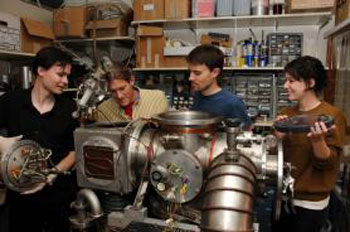 Physicists discovered a new way to measure how single atoms interact with surfaces. Their findings help develop nanotechnology and test new theories about the internal structure of atoms.
Physicists discovered a new way to measure how single atoms interact with surfaces. Their findings help develop nanotechnology and test new theories about the internal structure of atoms.
Jan 17th, 2011
Read more
 Nanotechnology issues are about to hit the mass media in a big way. The new EC-funded NANOCHANNELS project was launched last week with a two-day kick-off meeting that led to the planning of a dynamic programme of communication, dialogue, and engagement in issues of nanotechnology aimed at European citizens.
Nanotechnology issues are about to hit the mass media in a big way. The new EC-funded NANOCHANNELS project was launched last week with a two-day kick-off meeting that led to the planning of a dynamic programme of communication, dialogue, and engagement in issues of nanotechnology aimed at European citizens.
Jan 17th, 2011
Read more
Mehr als 200 Interessierte aus Betrieben und Behoerden nahmen am Dialog-Forum 'Nanomaterialien am Arbeitsplatz' teil, das die Bundesanstalt fuer Arbeitsschutz und Arbeitsmedizin (BAuA) heute in Dortmund veranstaltete. Im Mittelpunkt der Veranstaltung standen Forschungsergebnisse und praktische Hilfestellungen der BAuA, die zum verantwortungsvollen Umgang mit Nanomaterialien am Arbeitsplatz beitragen.
Jan 17th, 2011
Read more
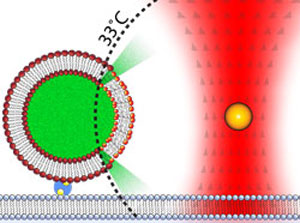 Tiny gold particles are good for transferring heat and could be a promising tool for creating localized heating in, for example, a living cell. In new experiments, researchers at the Niels Bohr Institute have measured the temperature of nano-sized gold particles with extreme precision and have examined their ability to melt the lipid membranes surrounding cells, paving the way for dissolving sick cells.
Tiny gold particles are good for transferring heat and could be a promising tool for creating localized heating in, for example, a living cell. In new experiments, researchers at the Niels Bohr Institute have measured the temperature of nano-sized gold particles with extreme precision and have examined their ability to melt the lipid membranes surrounding cells, paving the way for dissolving sick cells.
Jan 17th, 2011
Read more
Der Ausschuss fuer Gefahrstoffe (AGS) hat bei seiner Sitzung im November 2010 den vom AK Nanomaterialien des UA I des AGS erarbeiteten Sachstandsbericht zum Thema Nanomaterialien beraten und beschlossen, mit der Erarbeitung einer Bekanntmachung zur Umsetzung der Vorgaben der Gefahrstoffverordnung (GefStoffV) bei Taetigkeiten mit Nanomaterialien zu beginnen.
Jan 17th, 2011
Read more
An 18-month NASA research effort to visualize the passenger airplanes of the future has produced some ideas that at first glance may appear to be old fashioned. Instead of exotic new designs seemingly borrowed from science fiction, familiar shapes - but built with high-tech materials - dominate the pages of advanced concept studies.
Jan 16th, 2011
Read more
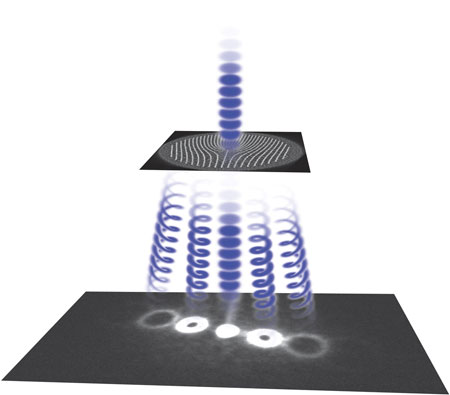 Electron microscopes are among the most widely used scientific and medical tools for studying and understanding a wide range of materials, from biological tissue to miniature magnetic devices, at tiny levels of detail. Now, researchers at the National Institute of Standards and Technology (NIST) have found a novel and potentially widely applicable method to expand the capabilities of conventional transmission electron microscopes (TEMs). Passing electrons through a nanometer-scale grating, the scientists imparted the resulting electron waves with so much orbital momentum that they maintained a corkscrew shape in free space.
Electron microscopes are among the most widely used scientific and medical tools for studying and understanding a wide range of materials, from biological tissue to miniature magnetic devices, at tiny levels of detail. Now, researchers at the National Institute of Standards and Technology (NIST) have found a novel and potentially widely applicable method to expand the capabilities of conventional transmission electron microscopes (TEMs). Passing electrons through a nanometer-scale grating, the scientists imparted the resulting electron waves with so much orbital momentum that they maintained a corkscrew shape in free space.
Jan 14th, 2011
Read more
The theme for the 2012 Bower Award and Prize for Achievement in Science is Nanochemistry. Notice of intent to nominate is encouraged: March 31, 2011. Complete Nomination: May 31, 2011
Jan 14th, 2011
Read more
Stanford physicist Ingmar Riedel-Kruse has begun developing 'biotic games' involving paramecia and other living organisms. He hopes the games lead to advances in education and crowd-sourcing of laboratory research while helping to raise the level of public discourse on bio-related issues.
Jan 14th, 2011
Read more
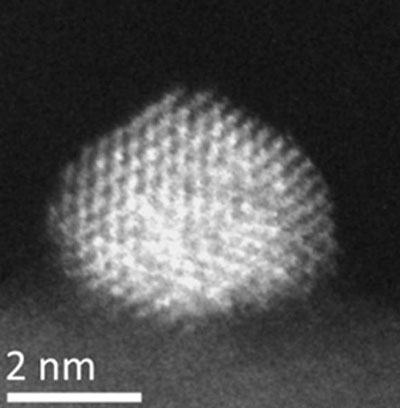 Nanoparticles of gold and palladium (Au-Pd) could lead to a more efficient and environmentally friendly way of producing benzyl benzoate, a chemical compound used widely in the food, pharmaceutical and chemical industries whose applications include a fixative for fragrances, a food additive and a solvent for chemical reactions.
Nanoparticles of gold and palladium (Au-Pd) could lead to a more efficient and environmentally friendly way of producing benzyl benzoate, a chemical compound used widely in the food, pharmaceutical and chemical industries whose applications include a fixative for fragrances, a food additive and a solvent for chemical reactions.
Jan 14th, 2011
Read more
The European Food Safety Authority has launched a public consultation on its draft guidance document for engineered nanomaterial (ENM) applications in food and feed.
Jan 14th, 2011
Read more
Magnetotactic bacteria orient themselves in their environment with the aid of tiny compasses, consisting of chains of membrane sacs called magnetosomes, each containing a single nanomagnet.
Jan 14th, 2011
Read more
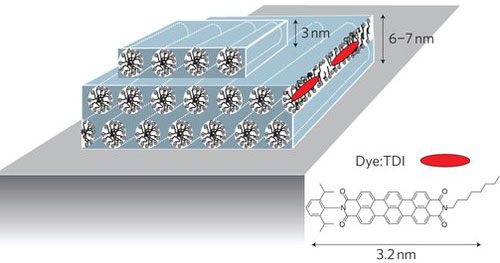 Wissenschaftler des Exzellenzclusters 'Nanosystems Initiative Munich' an derLMU haben eine Methode entwickelt, mit der sie Silikat-Nanoroehrchen trotz ihrer geringen Groesse direkt beim Wachsen zusehen koennen.
Wissenschaftler des Exzellenzclusters 'Nanosystems Initiative Munich' an derLMU haben eine Methode entwickelt, mit der sie Silikat-Nanoroehrchen trotz ihrer geringen Groesse direkt beim Wachsen zusehen koennen.
Jan 14th, 2011
Read more
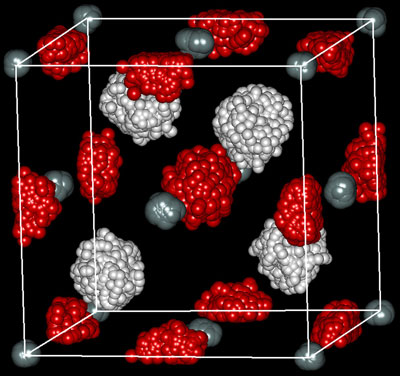 Most of our Universe consists of hydrogen atoms, which are often found under extraordinarily high pressure as high as tens of millions of times the atmospheric pressure of Earth. Understanding the exotic physics of such a high-pressure regime will contribute to our understanding of planet formation, hydrogen storage, room temperature superconductivity and other fields, explains Toshiaki Iitaka from the RIKEN Advanced Science Institute in Wako.
Most of our Universe consists of hydrogen atoms, which are often found under extraordinarily high pressure as high as tens of millions of times the atmospheric pressure of Earth. Understanding the exotic physics of such a high-pressure regime will contribute to our understanding of planet formation, hydrogen storage, room temperature superconductivity and other fields, explains Toshiaki Iitaka from the RIKEN Advanced Science Institute in Wako.
Jan 14th, 2011
Read more
Imaging system could help reveal 'miscommunications' in autism, schizophrenia.
Jan 14th, 2011
Read more
Nanopartikel spielen eine wesentliche Rolle bei der Entwicklung zukuenftiger diagnostischer und therapeutischer Methoden fuer Tumorerkrankungen, beispielsweise als Transporter fuer Wirkstoffe oder als Kontrastmittel. Aufnahme und Verteilung von Nanopartikeln im Tumorgewebe haengen dabei stark von der Partikelgroesse ab. Um dies systematisch untersuchen zu koennen, haben Wissenschaftler jetzt einen Satz fluoreszierender Nanopartikel verschiedener Durchmesser zwischen 10 und 150 nm hergestellt.
Jan 14th, 2011
Read more
 Physicists discovered a new way to measure how single atoms interact with surfaces. Their findings help develop nanotechnology and test new theories about the internal structure of atoms.
Physicists discovered a new way to measure how single atoms interact with surfaces. Their findings help develop nanotechnology and test new theories about the internal structure of atoms.






 Subscribe to our Nanotechnology News feed
Subscribe to our Nanotechnology News feed